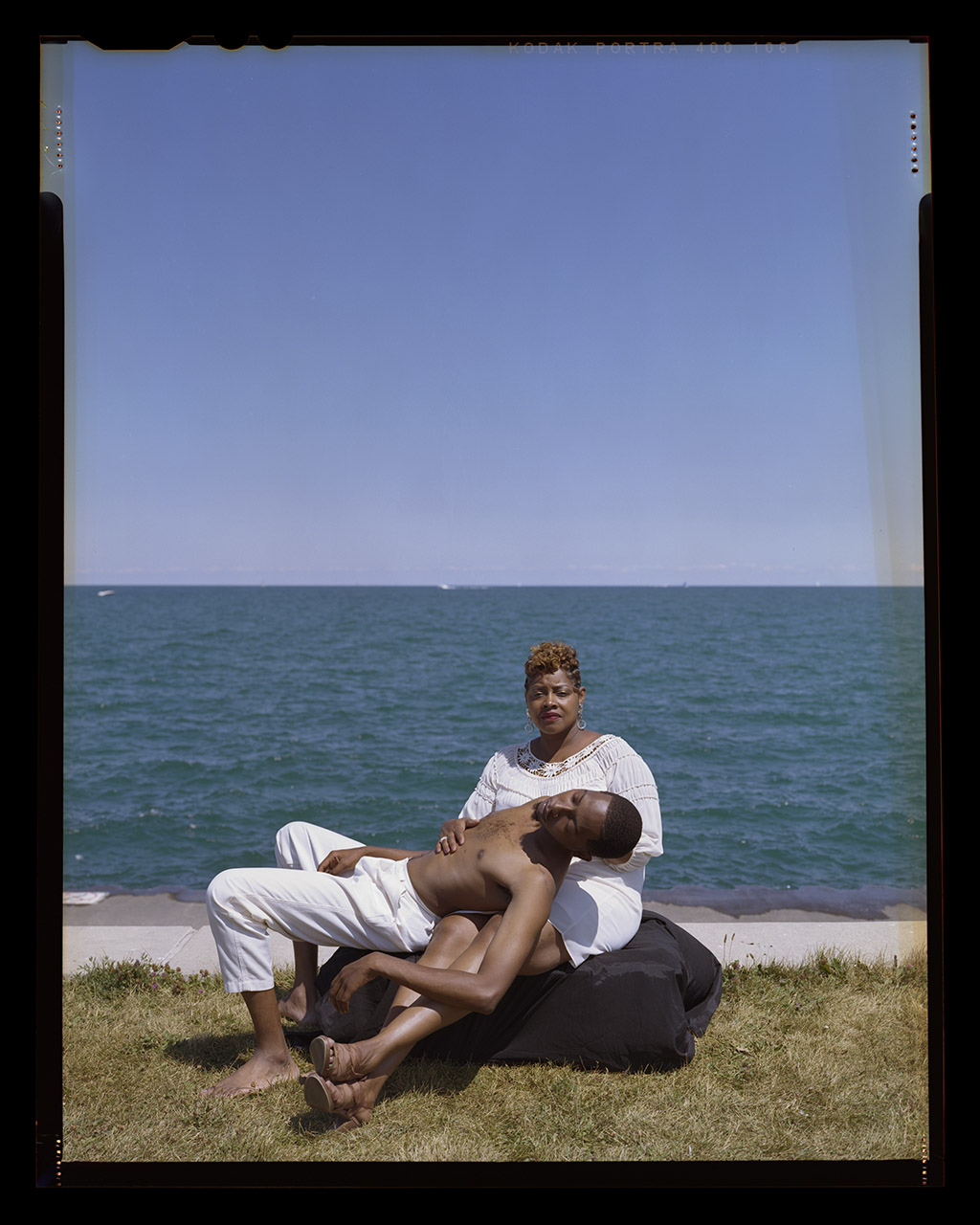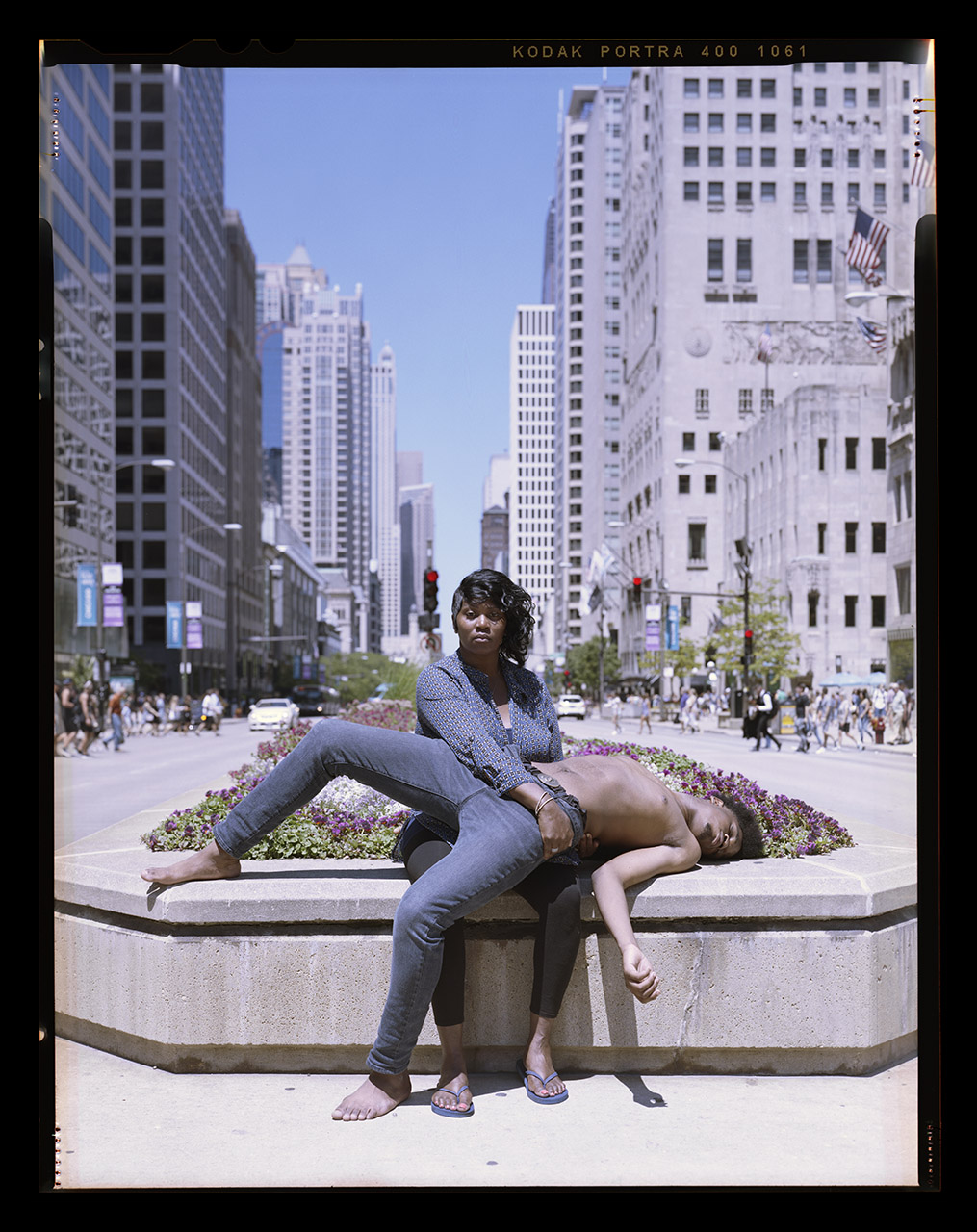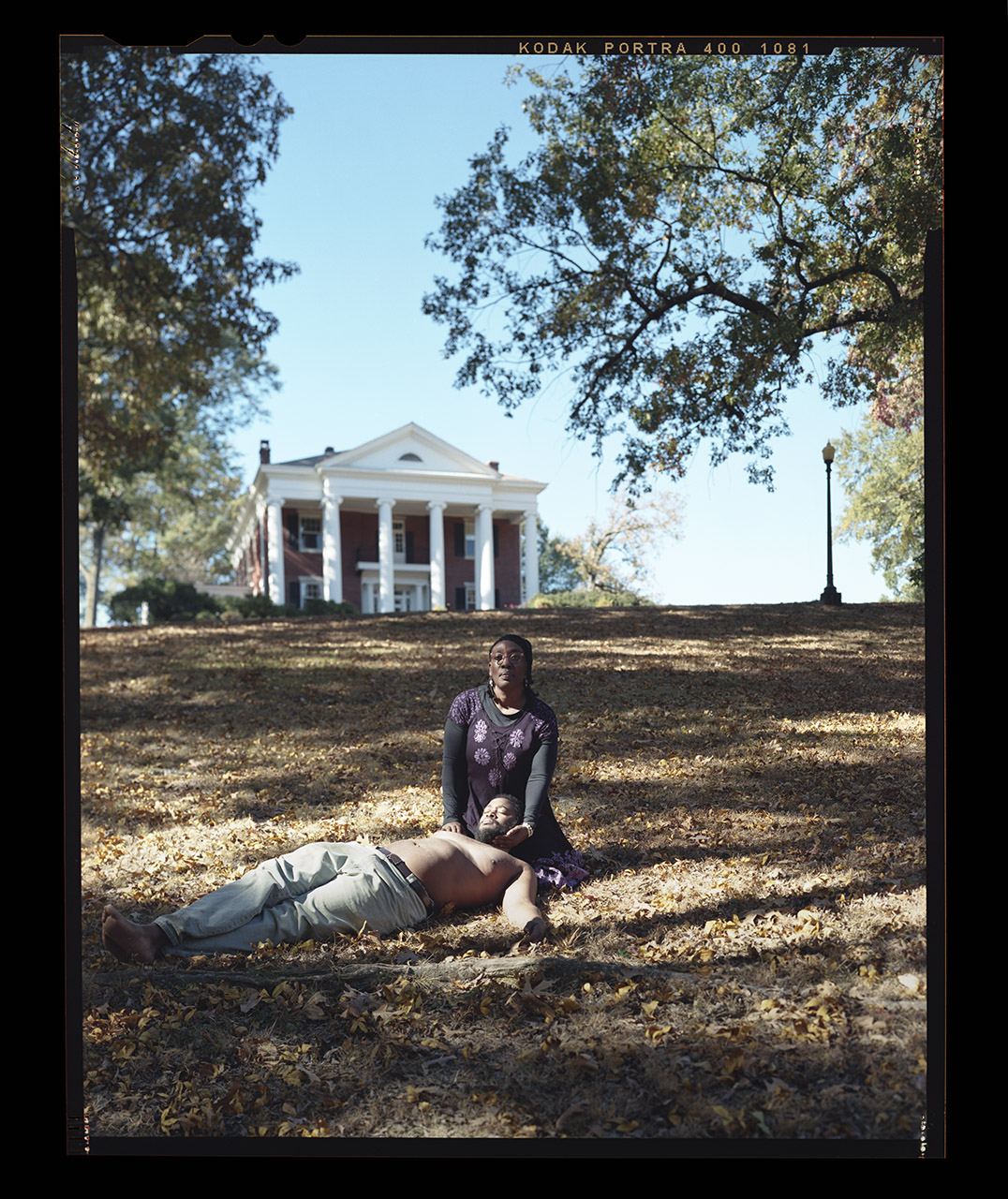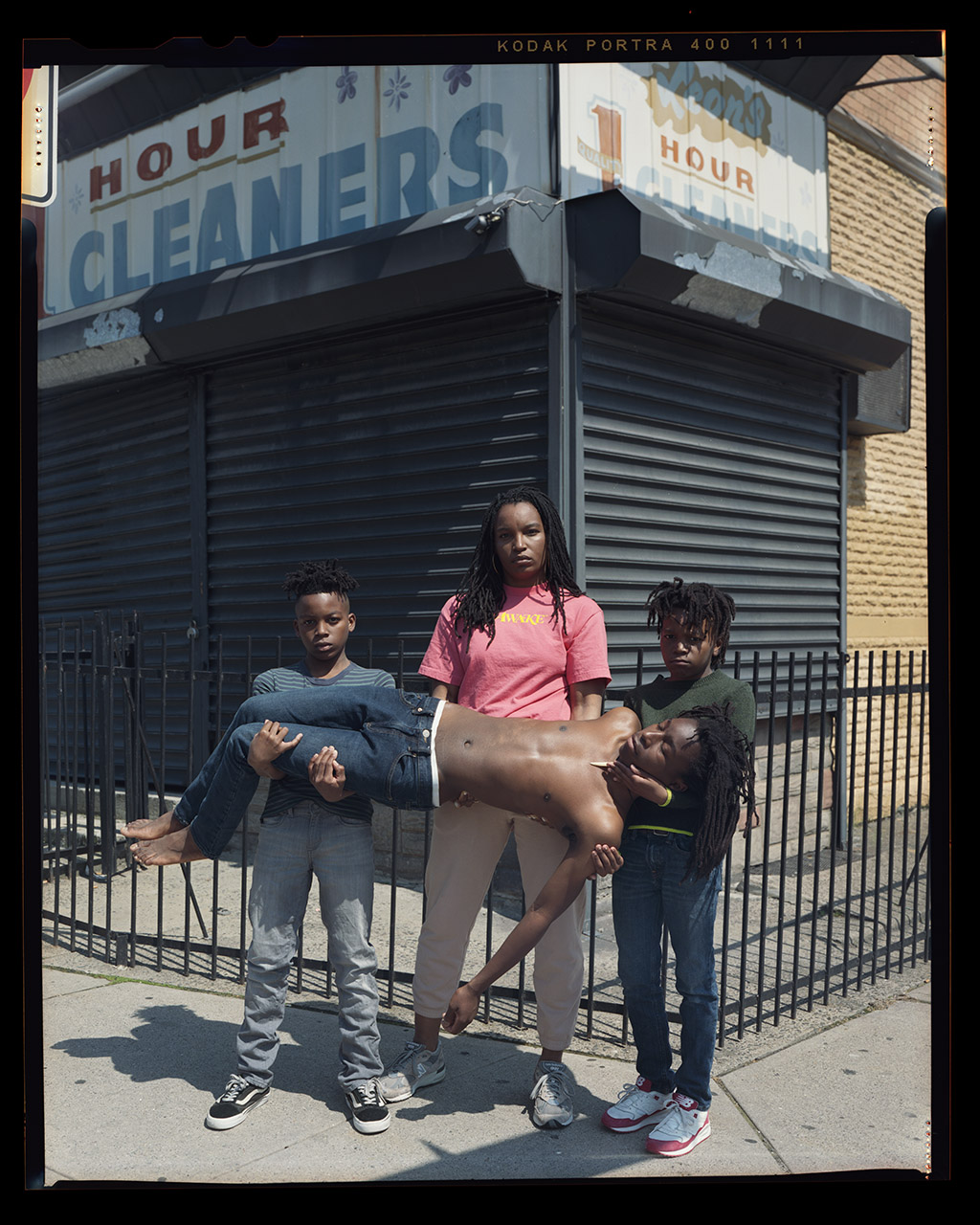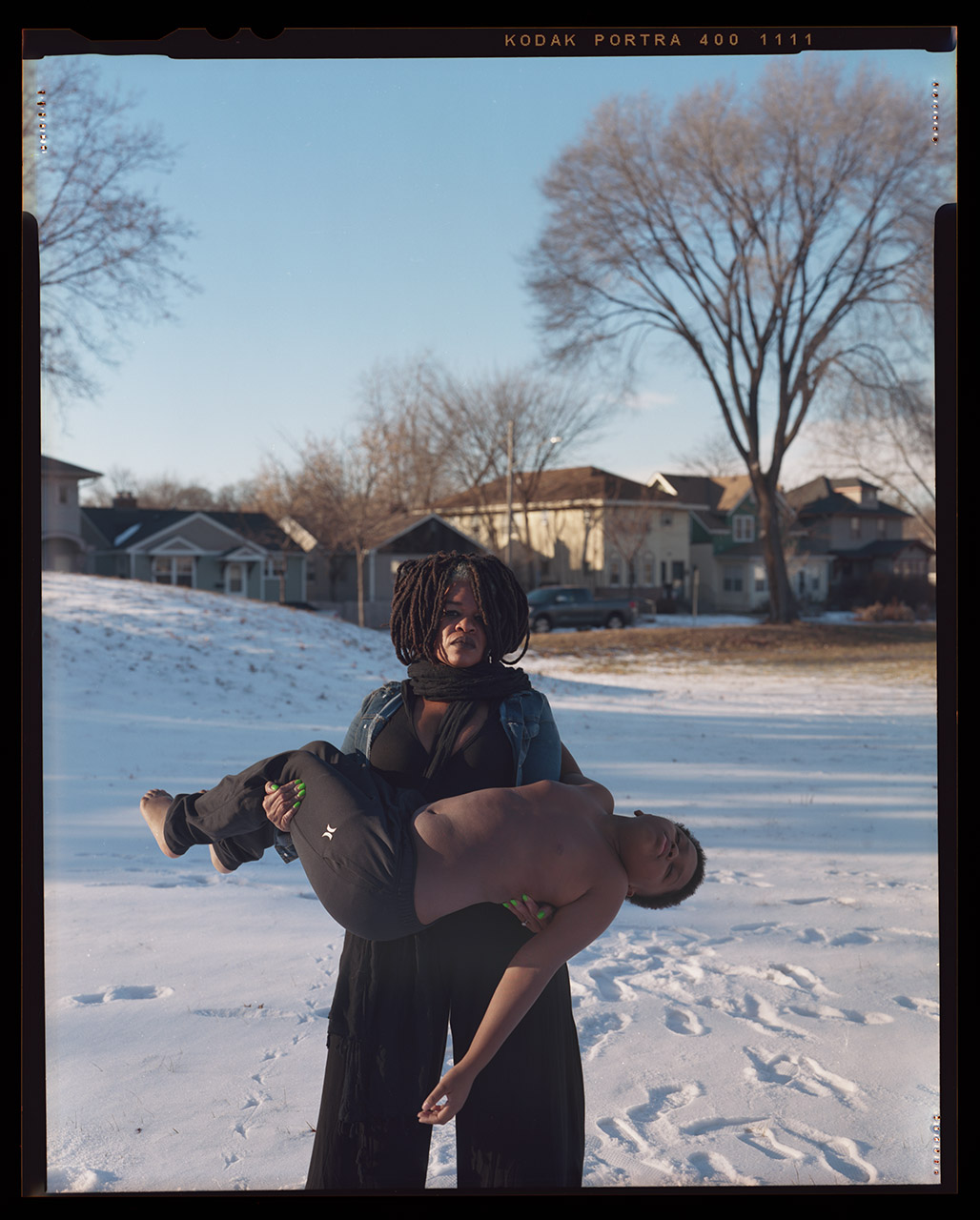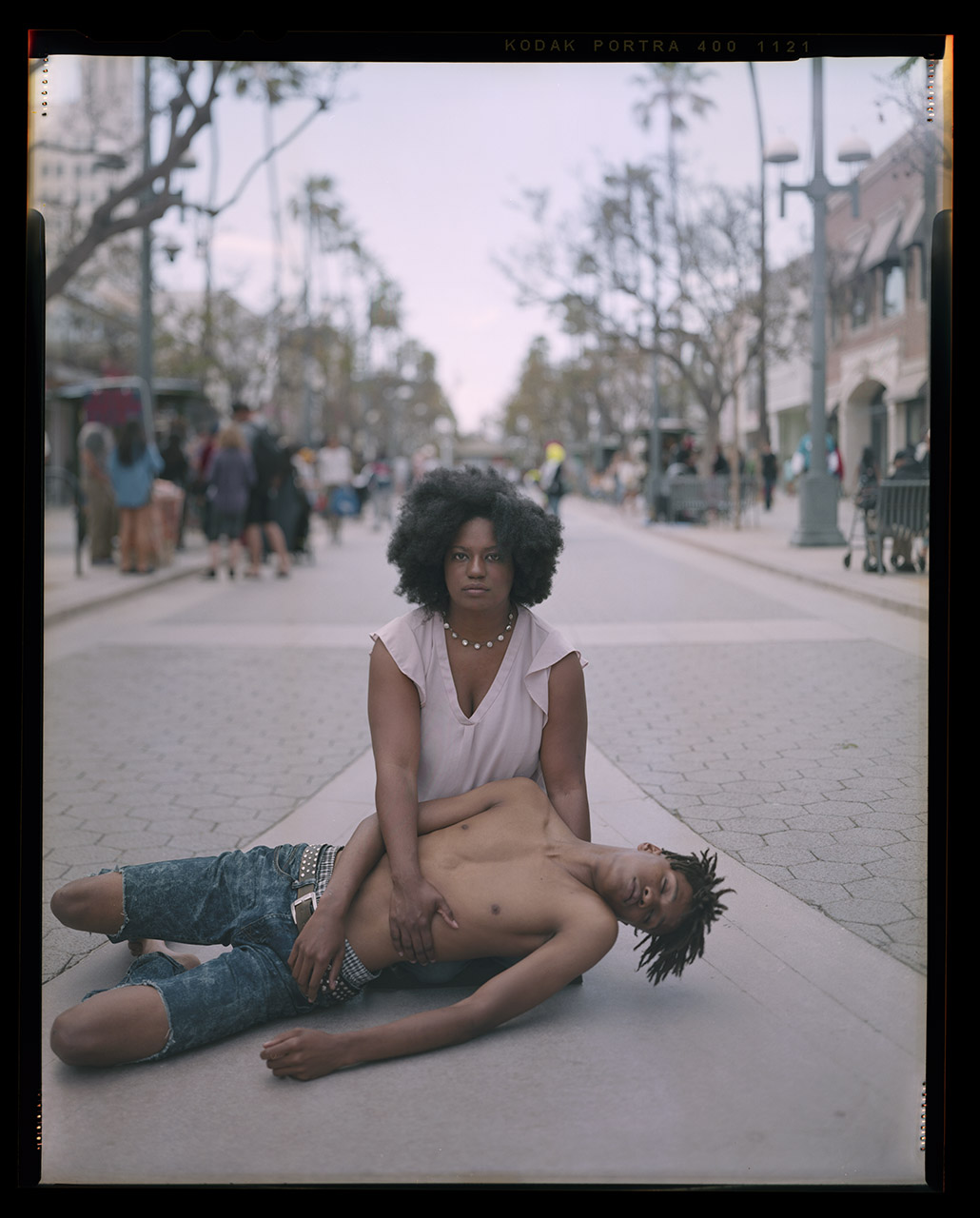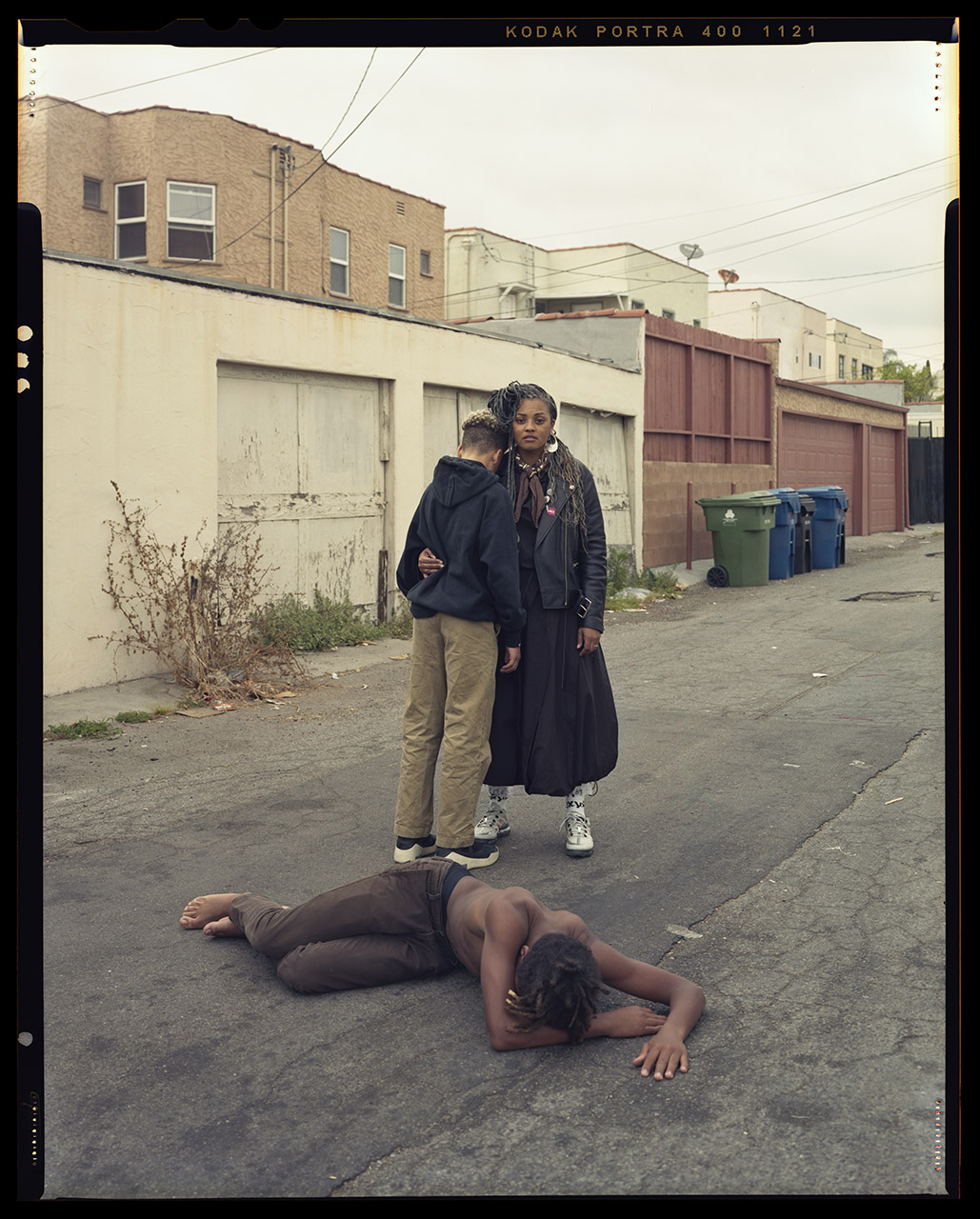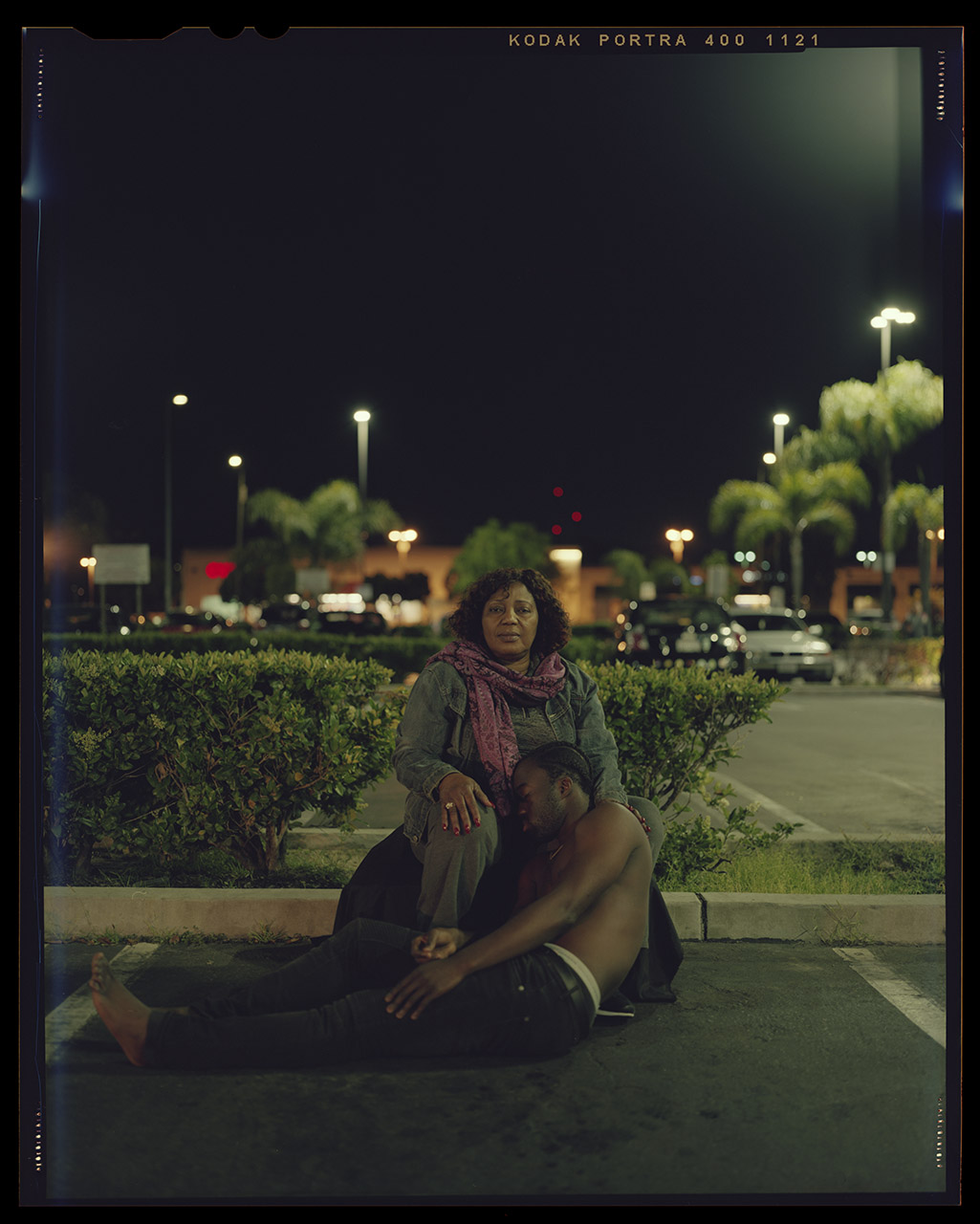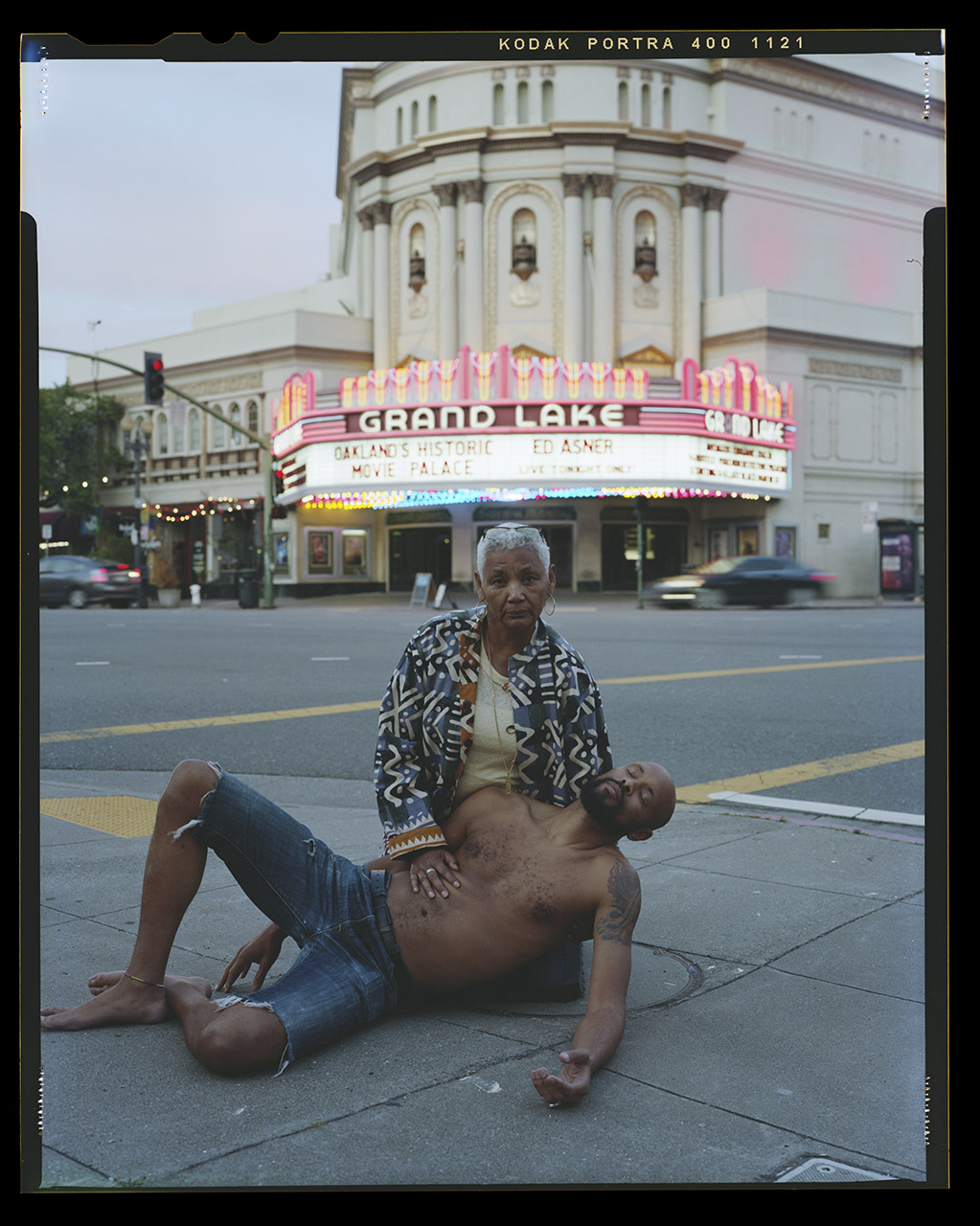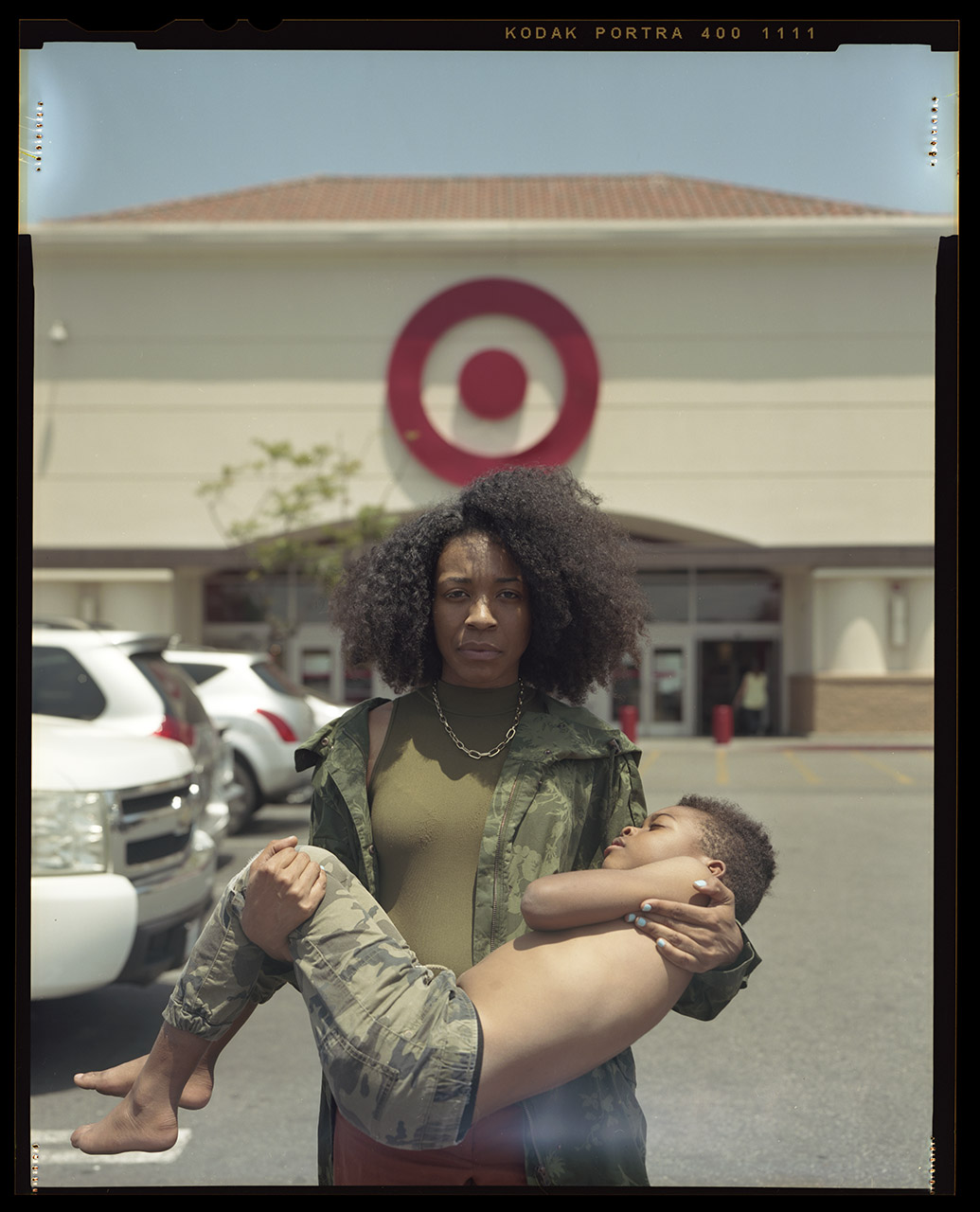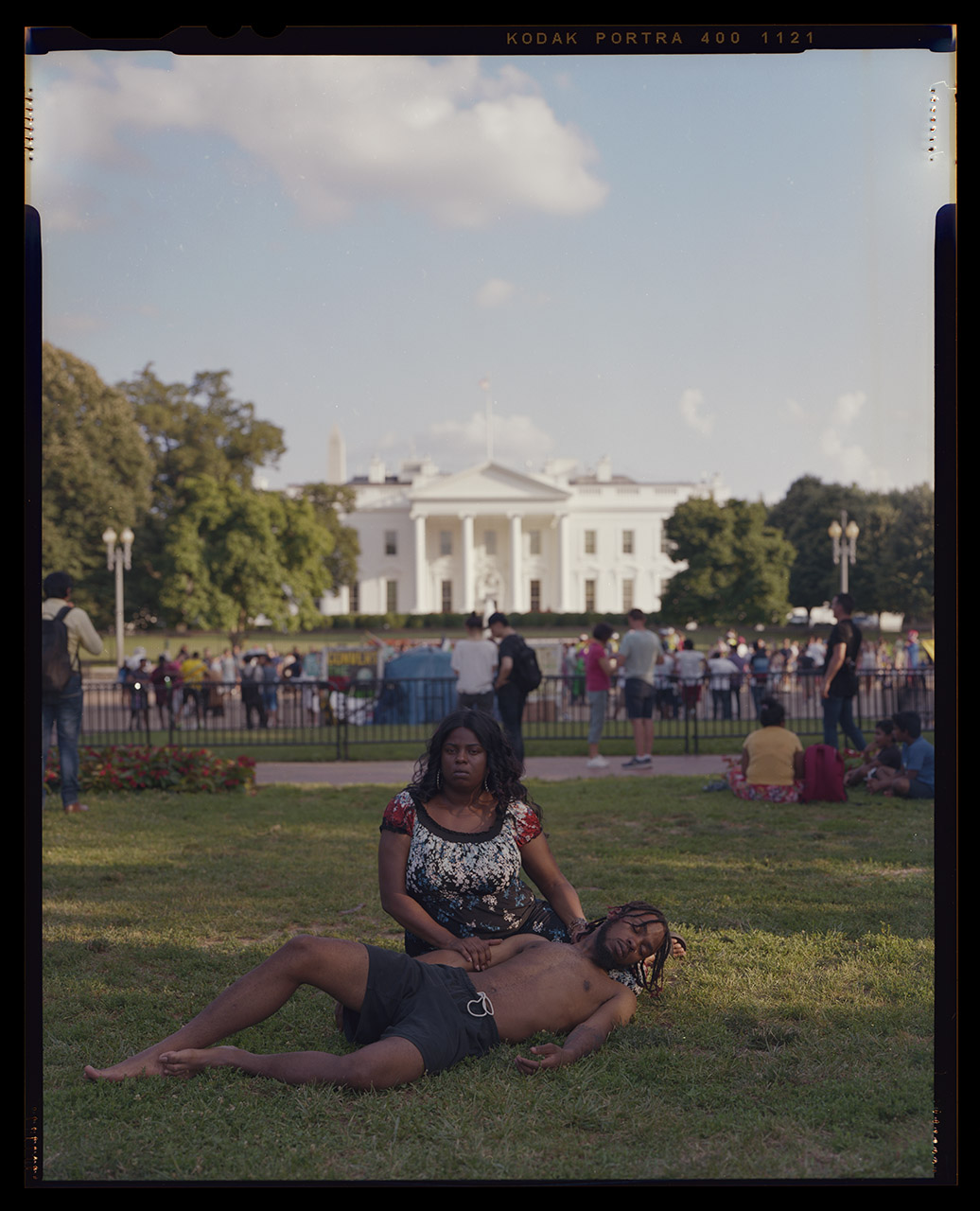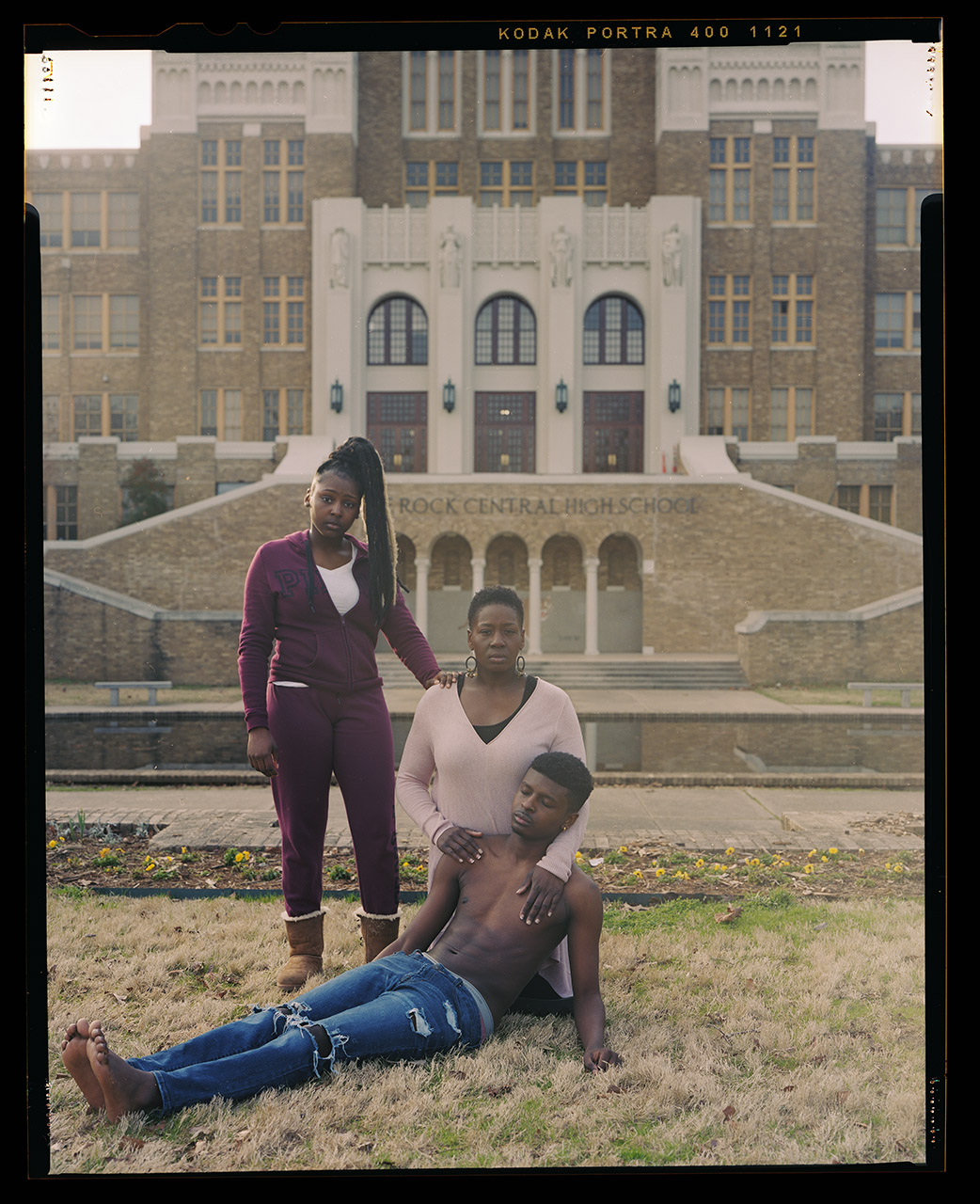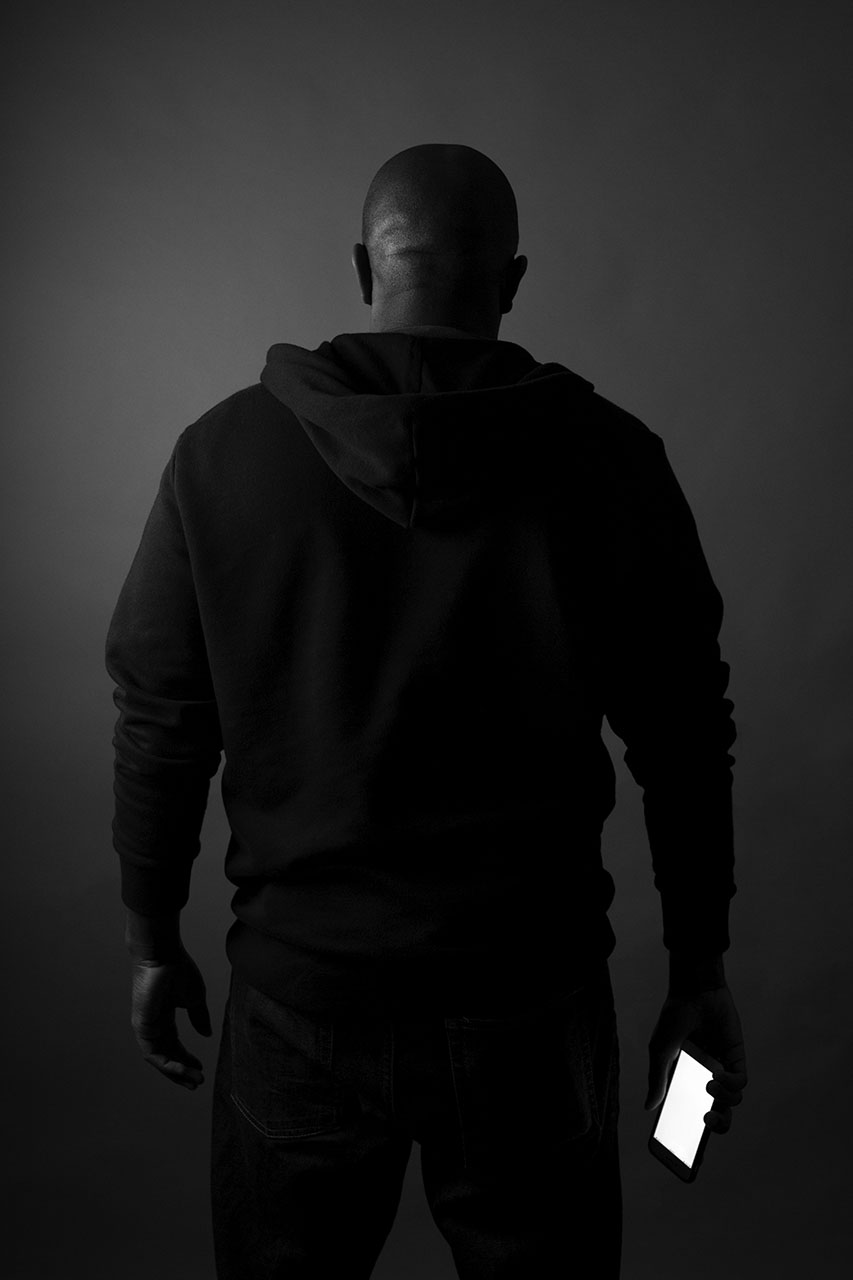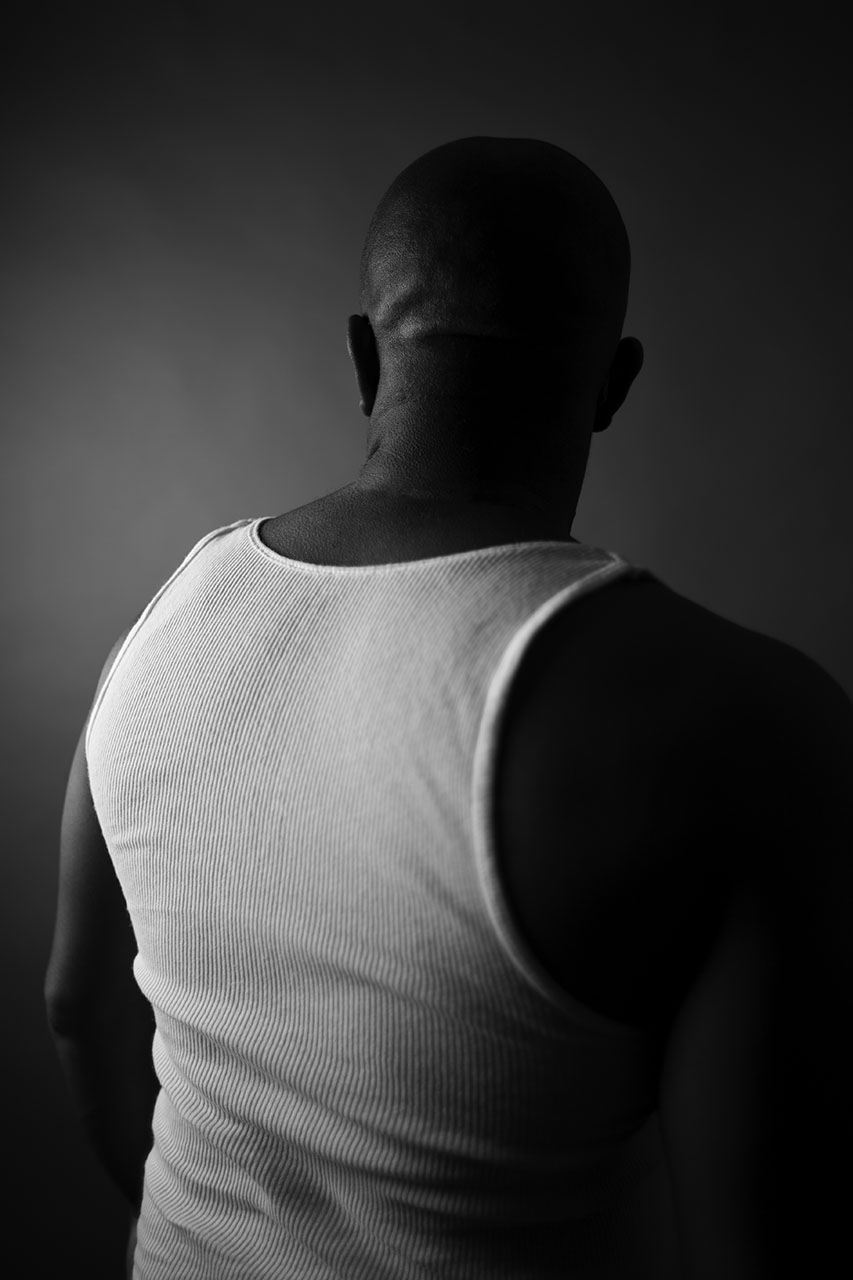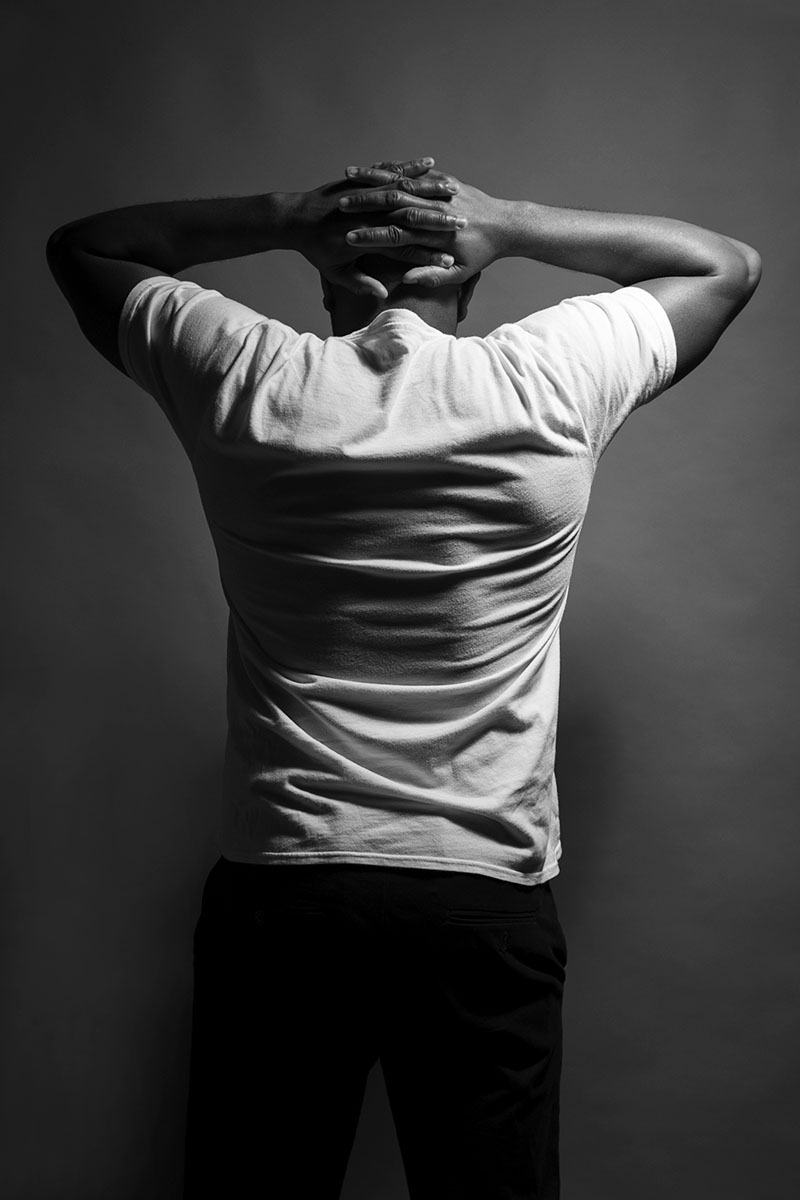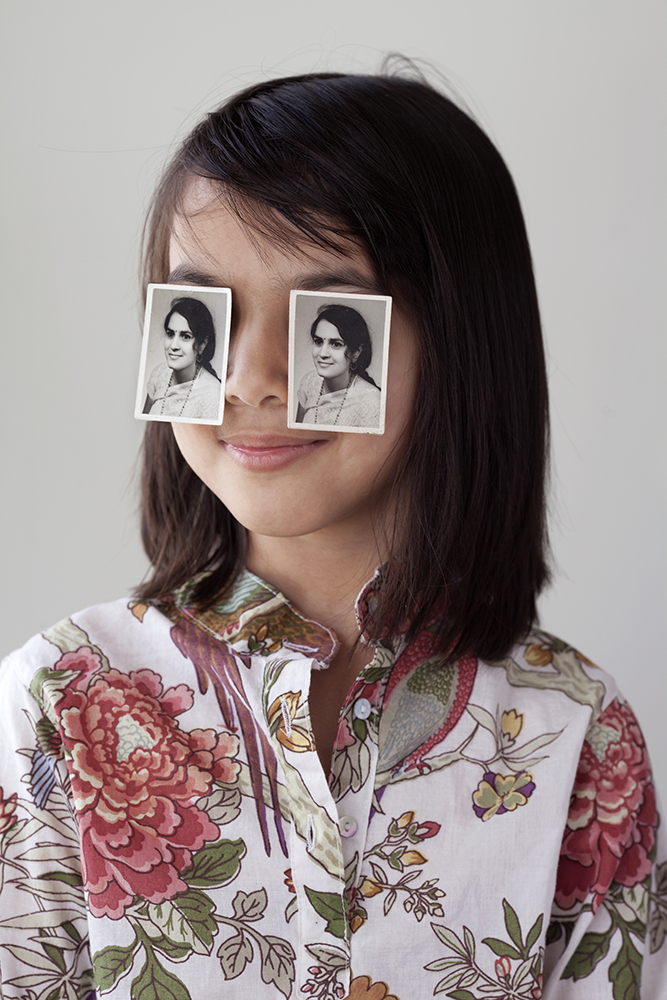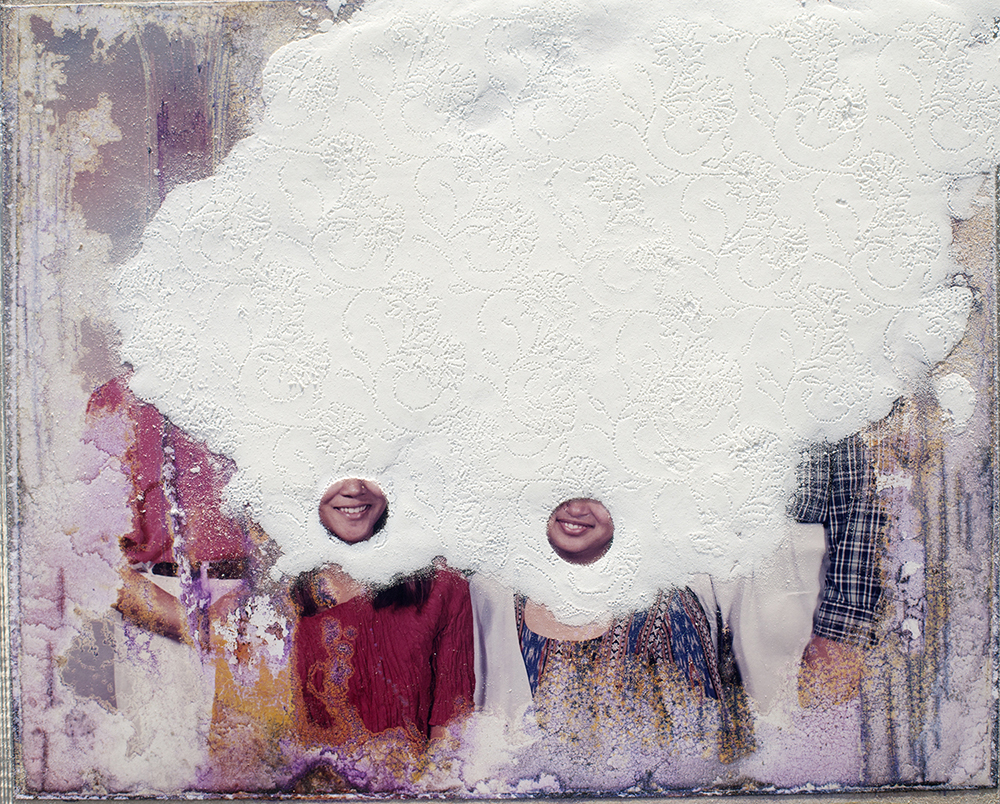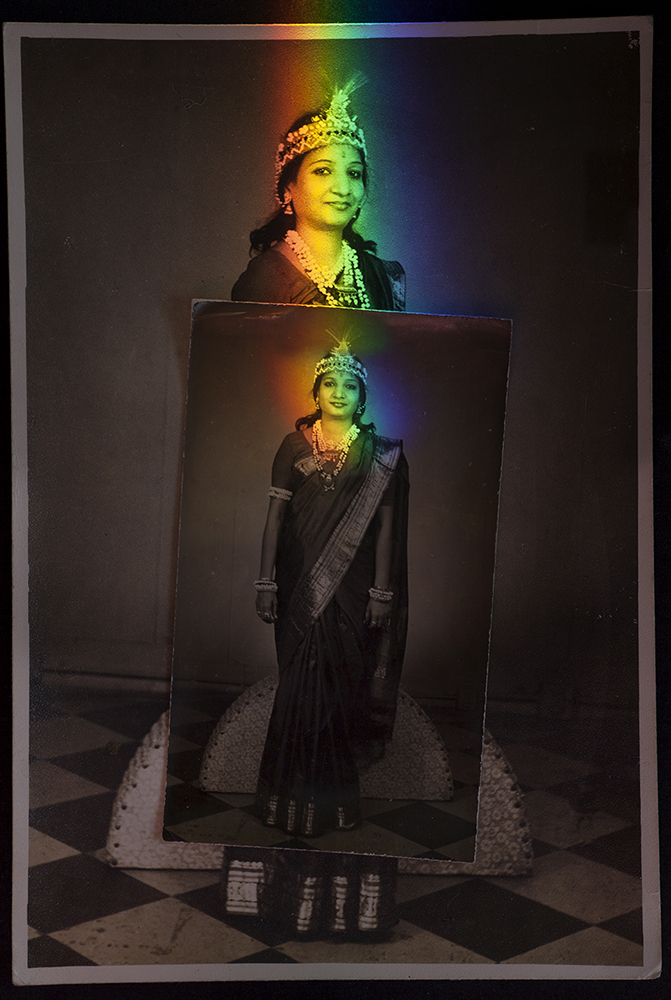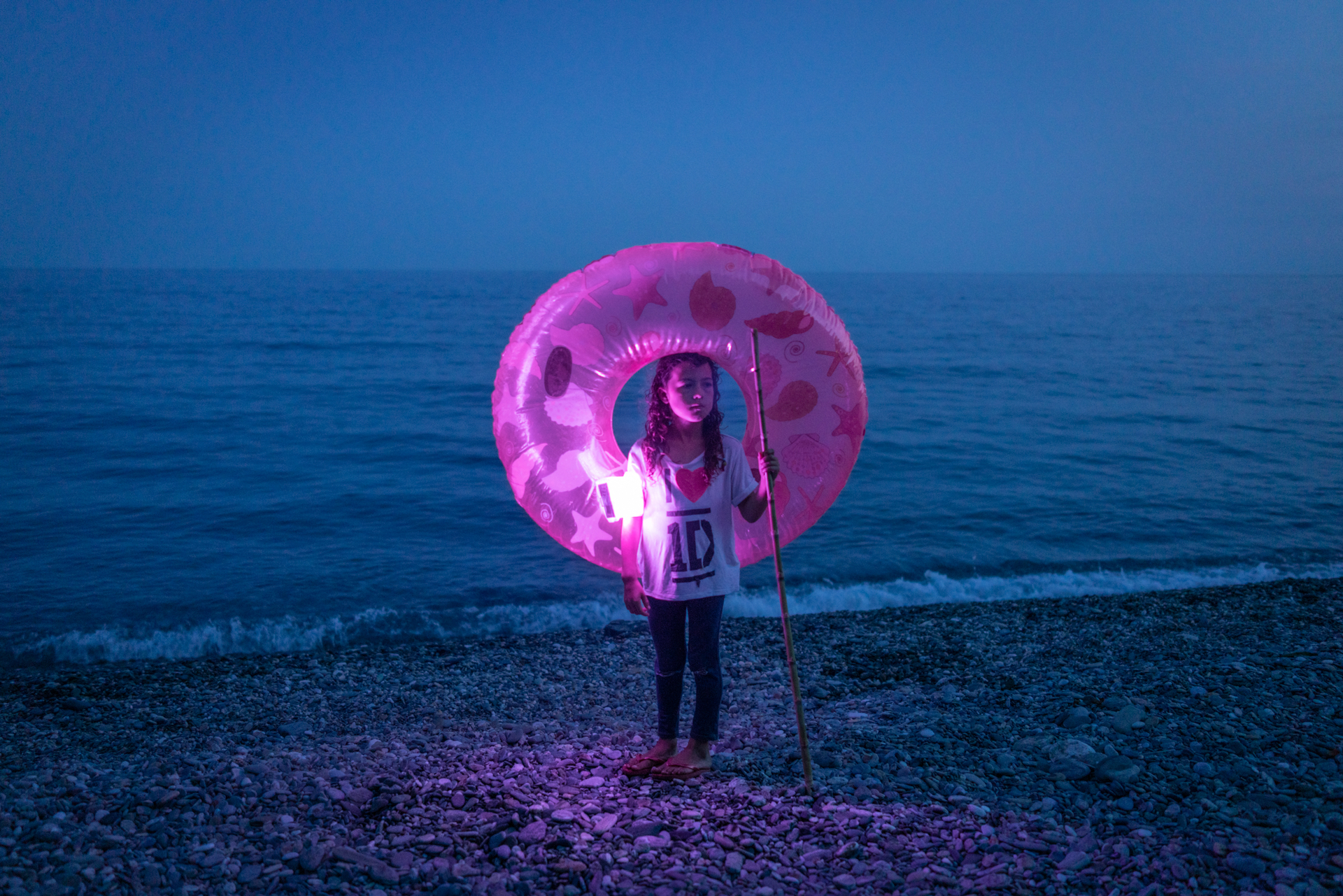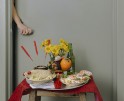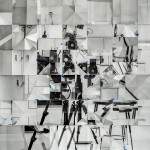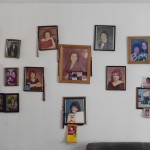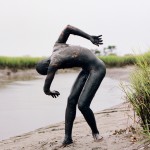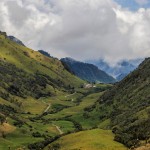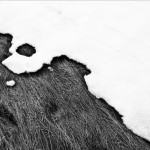The Arnold Newman Prize for New Directions in Photographic Portraiture
The Arnold Newman Prize for New Directions in Photographic Portraiture is a $20,000 prize awarded annually to a photographer whose work demonstrates a compelling new vision in photographic portraiture. In addition to the winner, the jury selects three finalists each year who are invited to participate in an exhibit at the Griffin Museum of Photography. The Prize is generously funded by the Arnold & Augusta Newman Foundation and proudly administered by Maine Media Workshops + College. The Griffin Museum of Photography hosts the annual exhibition of work by the winner and three finalists each October.
The recipient of the 2020 The Arnold Newman Prize for New Directions in Photographic Portraiture is Jon Henry. Henry’s award-winning work entitled Stranger Fruit was created in response to the senseless murders of black men across the nation by police violence. According to his artist statement,“Even with smart phones and dash cams recording the actions, more lives get cut short due to unnecessary and excessive violence.”
The finalists this year include The Talk by Michael Darough, Solar Portraits by Rubén Salgado Escudero, and Buttons for Eyes by Priya Kambli.
Selected by a jury of world-renowned photographers Makeda Best (Richard L. Menschel Curator of Photography at Harvard University), Aline Smithson (Los Angeles based visual artist, educator, and editor), and Dan Winters (award-winning portrait photographer, illustrator, filmmaker, and writer), each juror brought to the selection process a unique perspective guided by distinguished insight, analysis, and integrity.
“Arnold Newman had a profound influence on photographers in the latter half of the 20th Century,” noted Maine Media President Michael Mansfield. “That his legacy continues to shape conversations around photography, to support new generations of image makers – portraiture in the 21st century – is truly inspiring.”
Jon Henry is a visual artist working with photography and text, from Queens NY (resides in Brooklyn). His work reflects on family, sociopolitical issues, grief, trauma and healing within the African American community. His work has been published both nationally and internationally and exhibited in numerous galleries including Aperture Foundation, Smack Mellon, and BRIC among others. Known foremost for the cultural activism in his work, his projects include studies of athletes from different sports and their representations.
He was recently named one of LensCulture’s Emerging Artists for 2019, an En Foco Fellow for 2020 and he has also won the Film Photo Prize for Continuing Film Project sponsored by Kodak
Stranger Fruit
Stranger Fruit was created in response to the senseless murders of black men across the nation by police violence. Even with smart phones and dash cams recording the actions, more lives get cut short due to unnecessary and excessive violence.
Who is next? Me? My brother? My friends? How do we protect these men?
Lost in the furor of media coverage, lawsuits and protests is the plight of the mother. Who, regardless of the legal outcome, must carry on without her child.
I set out to photograph mothers with their sons in their environment, reenacting what it must feel like to endure this pain. The mothers in the photographs have not lost their sons, but understand the reality, that this could happen to their family. The mother is also photographed in isolation, reflecting on the absence. When the trials are over, the protesters have gone home and the news cameras gone, it is the mother left. Left to mourn, to survive.
The title of the project is a reference to the song “Strange Fruit.” Instead of black bodies hanging from the Poplar Tree, these fruits of our families, our communities, are being killed in the street.
Arnold Newman Portrait Prize Finalists
Michael Darough
Michael Darough graduated from the University of Memphis, earning an MFA in photography in 2011. He received his BFA in photography from Arizona State University in 2007. His work explores personal and cultural identity though tableau and portraiture. Darough received a Fulbright seminar grant addressing diversity in German education, which was hosted by the Eberhard Karls University of Tübingen in Baden-Württemberg, Germany. He is a nationally exhibiting artist whose work has recently been shown at the Brooks Museum of Art in Memphis, TN, the Center for Fine Art Photography in Fort Collins, CO and was a Silver Eye Fellowship 20 recipient. Currently he is an artist and educator working out off St. Louis, MO.
The Talk (2018-Present)
These images were created in response to the Black Lives Matter Movement. The faceless men represent individuals affected by this systemic issue. Those void of the figure symbolize the stories that struggle to be told; they ones that do not receive news coverage. Incarceration rates, racial profiling and fatalities from law enforcement disproportionately affect individuals of color. Police officers have the difficult task of protecting and serving our communities. They are people we depend on in common and extreme situations. I have nothing but respect for these women and men who risk their lives daily, but every black family still has to have “the talk” with their children; especially their sons. Every few months a high-profile story emerges about another individual who is a victim of the criminal justice system. These situations have become all too common.
Social media and the digital age have given us access to see how excessive force has been used in several situations with individuals of color. These problems are not new. As a country we transitioned from slavery and Jim Crow laws to segregation to civil rights. These issues went from overt to covert. Although these matters regarding race are better than they have been in decades, we still have problems within our society that have yet to be properly addressed and fixed.
Priya Kambli
Priya Kambli received her BFA at the University of Louisiana in Lafayette and an MFA from the University of Houston. She is currently Professor of Art at Truman State University in Kirksville, Missouri.
In her work Kambli, has always strived to understand the formation and erasure of identity that is an inevitable part of the migrant experience, exploring the resulting fragmentation of family, identity, and culture. This began with her Suitcase Series in 2006, which referenced her journey to the United States, and her act of distilling her entire life up until then to fit within a single suitcase, which weighed about 45 Kg. The same concerns carry through to her current body of work, Buttons for Eyes. In this body of work Kambli explores broader cultural debates around migration and identity, particularly as they have been recast in the dramatically changed context of anti-immigrant rhetoric now amplified at the highest levels of government, and which has altered the context in which migrant voices like hers are heard.
Kambli’s artwork has been well received, having been exhibited, published, collected and reviewed in the national and international photographic community. She was the winner of the inaugural Female in Focus, 2019 award – aimed at addressing the gender imbalance in the industry by highlighting the exceptional quality of work by female photographers around the world. The success of Kambli’s work underlines the fact that she is engaged in an important dialogue, and reinforces her intent to make work driven by a growing awareness of the importance of many voices from diverse perspectives and the political relevance of our private struggles.
My work has always been informed by the loss of my parents, my experience as a migrant, and an archive of family photographs I brought with me to America. For the past decade, this archive of family photographs has been my primary source material in creating bodies of work which explore the migrant narrative and challenges of cross-cultural understanding.
Buttons for Eyes
When I was a child, my inability to ever find anything, even objects right in front of me, lead to my mother’s playful question, “Do you have eyes or buttons for eyes?”. Intended as lighthearted criticism, her question summarized my inability to see, look, observe, find. Buttons for Eyes is my response to her playful yet nuanced question. A question laced with parental fear; if you can’t see, look, observe, find then how will you successfully navigate the world? Now that I am older than my mother was when she said those words, I see the world from my adopted home in the United States, and from within an environment of heightened anti-immigrant rhetoric which has altered the context in which migrant voices like mine are heard. Using the photographic lens, I strive to understand the formation and erasure of identity that is an inevitable part of the migrant experience by providing a much-needed personal perspective on the resulting fragmentation of family, identity, and culture.
Despite these weighty issues, there is playfulness embedded in the very title Buttons for Eyes. I am imagining what we might see with our button eyes; suggesting that seeing clearly calls for seeing the world in more unusual ways. Play occurs in this work in my use of both color and natural light. These are materials to manipulate; split into sparks, smear into rainbows, and find shimmering back from the depths of powdered pigments. In this series my concern for the past that is lost to me is apparent, but so is my concern for the future and the losses that will come. And although this work mythologizes the past and present it also plays games with them. It winks, pokes and inverts – suggesting joyousness – mixed with the loss and regret that accompanies us all.
Rubén Salgado Escudero
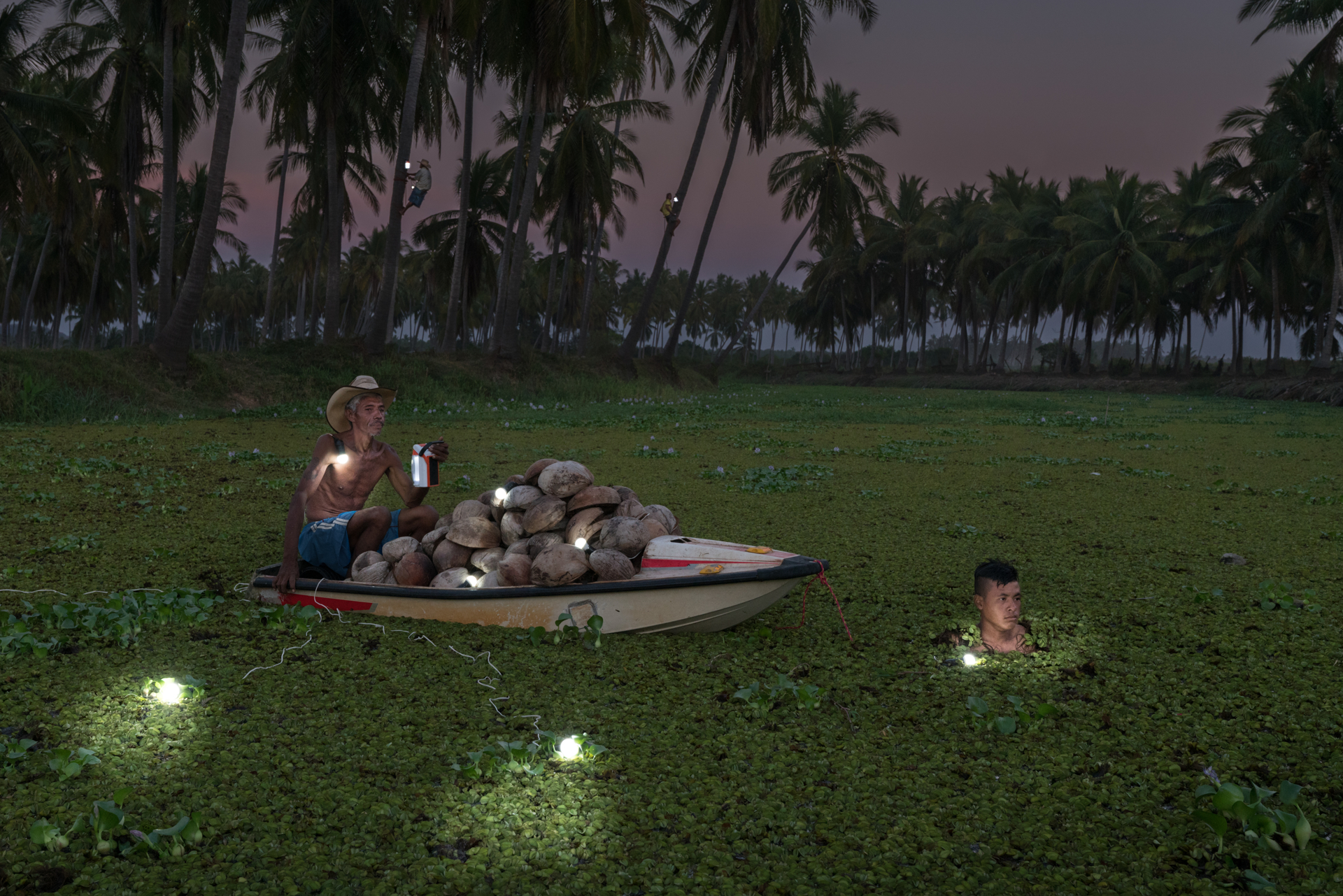
©Rubén Salgado Escudero, Cristobal Cespedes Lorenzo (51) sits on his raft while carrying coconuts across the river to his home in Copala, on the coast of Mexico’s state of Guerrero. Cristobal and Francisco Manzanares Cagua (16) both work picking coconuts which they then sell to a company which makes coconut butter and oil.
Rubén Salgado Escudero was born in Madrid, Spain. He lived in the United States throughout his teenage years, graduating from the Savannah College of Art and Design. In 2014 he decided to change his life completely, leaving behind a ten-year long career in 3D-character animation in Germany. Instead he leaves for Myanmar to pursue his passion for photography and document the opening of a country that had been closed to the world for more than half a century. Today he is based in Mexico.
Rubén’s works have been exhibited in over 20 cities worldwide including New York, London, Tokyo and at the Les Rencontres d’Arles photo festival in France. He is a member of The Photo Society, a community of National Geographic Magazine photographers. As an experienced lecturer, Rubén has given a TedX Talk in Beijing, and continues giving talks worldwide for National Geographic Learning, and other institutions such as Museo Soumaya in México City and the Sony Gallery in New York City.
His projects have been published in most major international publications, and has won various international awards including the Sony World Photography Award two years in a row and the POY Latam (Picture of the Year). More of his work can be seen on his instagram @rubensalgadoescudero or www.rubensalgado.com
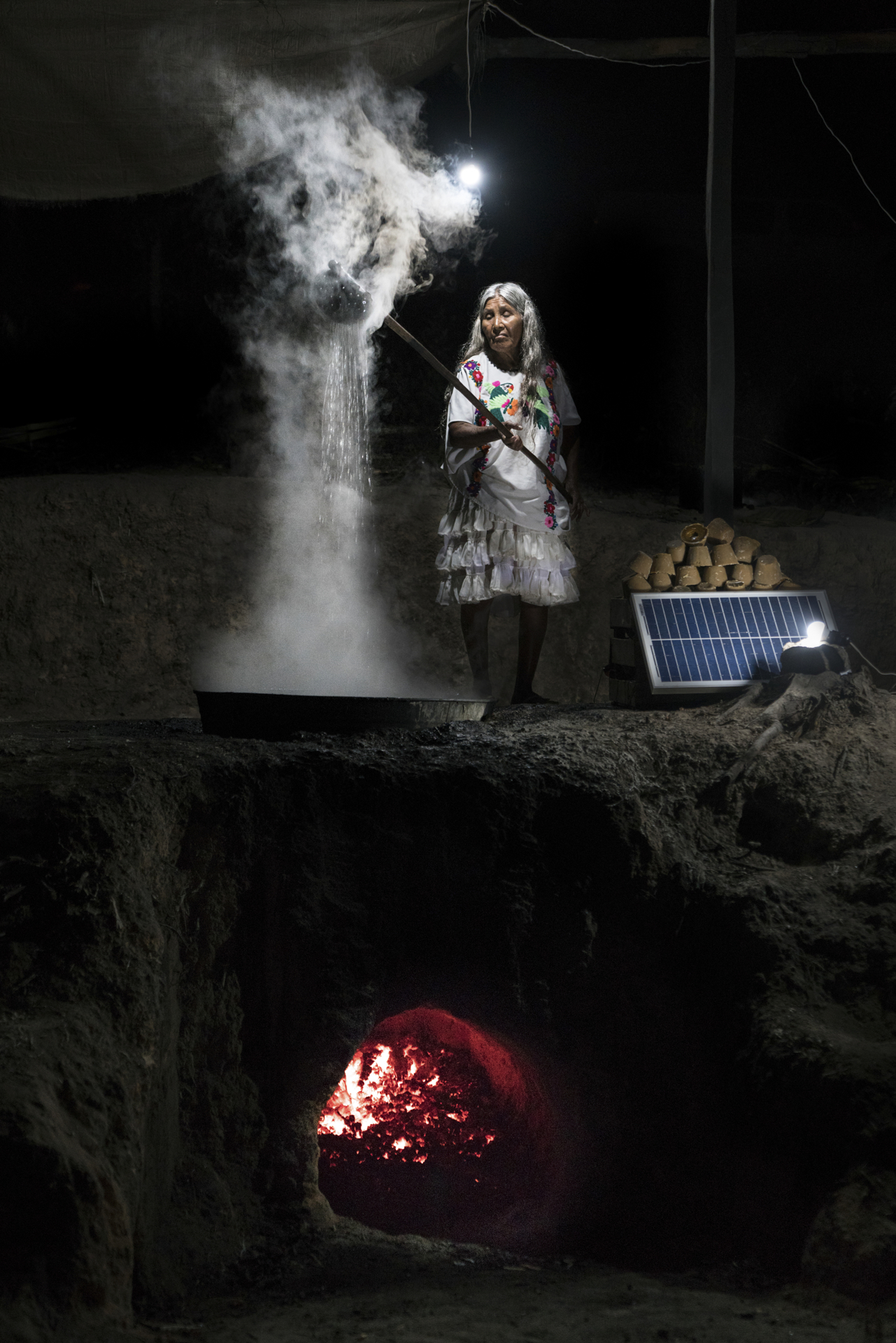
©Rubén Salgado Escudero, Maria Magdalena Carmen Mendoza (70) makes ”Panela”’ or ”Piloncillo” at her home in Llano Silleta, Guerrero Mexico. Panela is unrefined whole cane sugar, which is a solid form of sucrose derived from the boiling and evaporation of sugarcane juice. The name piloncillo means little loaf, because of the traditional shape in which this smoky, caramel-like and earthy sugar is produced. It has far more flavor than brown sugar, which is generally just white sugar with a small amount of molasses added back to it.
Solar Portraits
The International Energy Agency estimates that roughly 1.1 billion people in the world still live without access to electricity. For many communities worldwide candles, which are both expensive and dangerous, are the only source of light available once the sun sets. As building the requisite infrastructure to connect remote and rural villages to the grid will still take a long time, solar energy is a viable and much-needed solution that has the potential to improve the lives of millions immediately. Small, inexpensive photovoltaic power (PV) systems can provide households with 12 hours of light during the night, allowing people to do more with their waking hours at no additional cost.
Looking at the larger picture of our planet’s environment, solar energy has the potential to make a substantial positive impact on the earth’s C02 footprint. The Environmental Protection Agency shows that generating electric power causes over a third of all greenhouse gas emissions so reducing the electricity we draw from the grid means reducing carbon emissions.
These portraits depict the lives of people, many of which for the frst time have access to electricity through the power of solar energy. Locations are chosen that have pre-existing access to solar technology, so that the storytelling expresses the direct experience of individuals within the community. Each protagonist was asked how having
electricity has affected their life. The scenes have all been lit only by solar powered light bulbs, most their own, which are contributing to the improvement in these people’s standard of living.
Solar Portraits is not only an artistic project, but has foundation support with registered non-proft (501(c)3) status for its growing social impact initiative. The series has become an educational tool, bringing workshops and creative programming to the youngest members of communities documented which leads to collaboration with reciprocity. Students build a simple solar lamp or solar art project, with a focus on opening the door for bright young minds to learn about themes of solar energy innovation, global citizenship, and personal empowerment.
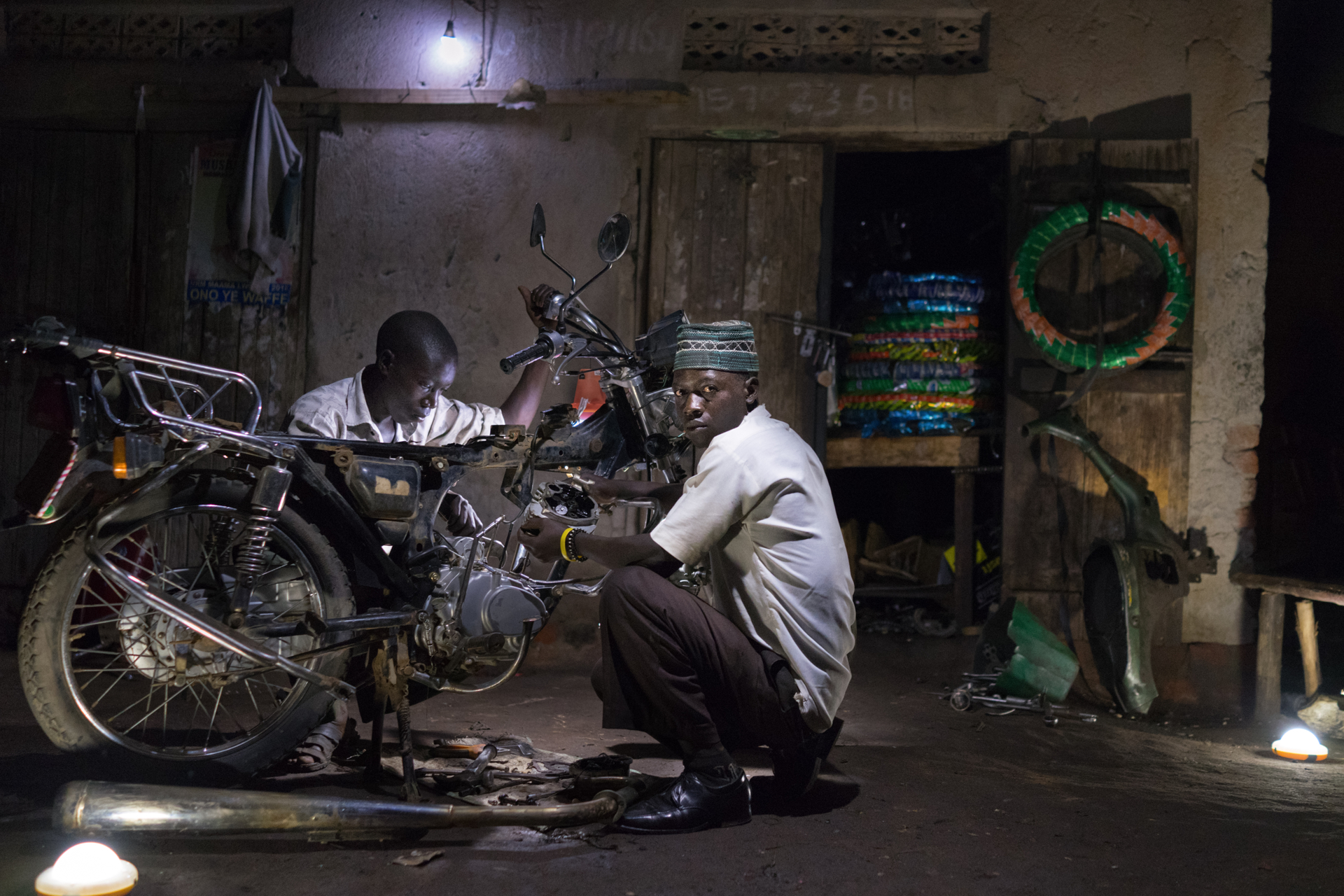
©Rubén Salgado Escudero, Ibrahim Kalungi and Godfrey Mteza, both 20, work at night in their motorcycle repair shop in Nbeeda, Uganda. The mechanics credit solar lights with enabling them to work longer hours and earn more money. Electricity is a rare luxury in Uganda.

©Rubén Salgado Escudero, Kogui men play music during a Cualama ceremony at night in ‘la Casa Maria’ a meeting space for men only in Waniyacka community. Cualama is a 10 day ritual which happens twice a year, in April and June paying honor to the change in season, mother nature and asking for abundant rains for a good harvest. This community made up of 55 homes within Colombia’s La Guajira, all have solar panels as they are too remote to be connected to the grid. The Kogi meaning ÔJaguarÕ are an indigenous ethnic group living in ColombiaÕs Sierra Nevada, deeply rooted in their belief that people and nature are one. They understand the Earth to be a living being and see humanity as its ÔÕchildrenÕÕ. They are unique among Latin AmericaÕs indigenous cultures because the Spaniards never conquered them. They represent the most complete surviving civilization of pre-Colombian America.
Posts on Lenscratch may not be reproduced without the permission of the Lenscratch staff and the photographer.
Recommended
-
The 2024 Lenscratch Student Prize Honorable Mention Winner: Andrew ZouJuly 26th, 2024
-
The 2024 Lenscratch Student Prize Honorable Mention Winner: Joseph Ladrón de GuevaraJuly 26th, 2024
-
The 2024 Lenscratch Student Prize Honorable Mention Winner: Anh NguyenJuly 25th, 2024
-
The 2024 Lenscratch 3rd Place Student Prize Winner: Mehrdad MirzaieJuly 24th, 2024
-
The 2024 Lenscratch 2nd Place Student Prize Winner: Ariana GomezJuly 23rd, 2024

